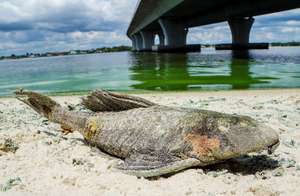 This story hits very close to home. My wife is from Hutchinson Island, on the Treasure Coast, and we spend a lot of time there at the area’s beaches. Just yesterday, Florida Governor Rick Scott declared a State of Emergency for St. Lucie and Martin County. The Governor issued Executive Order 16-155, which will allow both state and local governmental agencies to take the necessary action to mitigate the spread of algal blooms in the St. Lucie and Caloosahatchee estuaries by redirecting the flow of water in and out of Lake Okeechobee. The Governor also asked the Florida Department of Environmental Protection (DEP) and the Florida Fish and Wildlife Conservation Commission (FWC) to take action to fight the bloom. Area beaches are closed.
This story hits very close to home. My wife is from Hutchinson Island, on the Treasure Coast, and we spend a lot of time there at the area’s beaches. Just yesterday, Florida Governor Rick Scott declared a State of Emergency for St. Lucie and Martin County. The Governor issued Executive Order 16-155, which will allow both state and local governmental agencies to take the necessary action to mitigate the spread of algal blooms in the St. Lucie and Caloosahatchee estuaries by redirecting the flow of water in and out of Lake Okeechobee. The Governor also asked the Florida Department of Environmental Protection (DEP) and the Florida Fish and Wildlife Conservation Commission (FWC) to take action to fight the bloom. Area beaches are closed.
And while things are bad now, it is anticipated that they will only get much worse. The algae is currently making oxygen, but also blocking sunlight, and therefore killing algae and sea grass. Once the algae and grass dies off, that food source is lost to the areas fish and animals. The animals who are eating this algae, are absorbing microcsystin, a toxin. Animals that are able to come to the surface for air, like dolphins and manatees, become coated in the algae, which can affect their skin and respitory systems. People are being advised to stay out of the water as well, as it is believed the algae can cause skin rashes and possible respitory problems.








Neurotoxin-FloridaAlgaeBloom
AgPollution
Symptoms:
Diarrhea,Vomiting,LiverDamage
FishManatee’GatorDeaths
https://t.co/VIKQMa4lsk
The worst part is that this could have been prevented.
Its such a shame!
Chances are it is due to some huge runoff that contains phosphates and nitrates. In other words chemical waste from a business or excessive fertilizer usage.